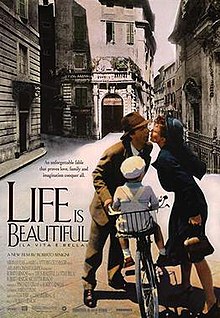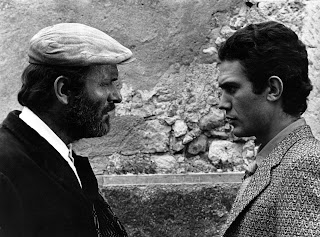NEW - Omero Antonutti - actor and voice dubber
Narrator of Oscar-winning Life is Beautiful had long career
The actor Omero Antonutti, who acted in around 60 films and was the Italian voice of many international stars, was born on this day in 1935 in Basiliano, a village about 13km (eight miles) west of the city of Udine in the Friuli-Venezia Giulia region of northeast Italy. His most acclaimed performance came in Padre padrone, a 1977 film directed by Paolo and Vittorio Taviani, a Palme d’Or winner at Cannes that was considered by many critics to be the co-directing brothers’ finest work. Antonutti worked with the Taviani brothers again on La notte di San Lorenzo (1982), which won the Grand Prix du Jury at Cannes, and Kaos (1984), in which he took the part of the playwright Luigi Pirandello in a film based on some of Pirandello’s own short stories. He was often asked to portray significant figures in dramatisations of real-life events. For example, he took the part of Roberto Calvi, the ill-fated chairman of the Banco Ambrosiano in the Giuseppe Ferrara’s 2002 feature The Bankers of God: The Calvi Affair, and played the shady Sicilian banker Michele Sindona in Michele Placido’s 1995 film Un eroe borghese - A Bourgeois Hero. Read more…
______________________________________
Imperia Cognati - courtesan
Prostitute who became a celebrity
Imperia Cognati, who acquired celebrity status in Rome in the early 16th century as a courtesan to a number of rich and powerful figures, was born on this day in 1486. Courtesans were originally the female companions of courtiers of the papal court, whose duties required them to be educated and familiar with etiquette, so that they could participate in the formalities of court life and take part in polite conversation. In time, however, in some cases their companionship became of a more intimate nature and they became the mistresses of their courtiers, who in the papal court were clerics not permitted to marry. It was common, too, for courtesans to be the companions of several clients simultaneously. They were in effect a new class of prostitute, refined and educated enough to hold their own in polite society. Imperia Cognati acquired her elevated status mainly through being the chosen companion of Agostino Chigi, a Sienese banker closely associated with Pope Alexander VI and others and a patron of the Renaissance. At one time he was thought to be the richest banker in the world. He lavished Imperia – as she was usually known – to the extent that she could afford to keep both a palace in Rome and a country villa. Read more…
______________________________________
Antonio da Sangallo the Younger - architect
Talented Florentine was commissioned by the Popes
Antonio da Sangallo the Younger, who left his mark on Rome during the Renaissance, died on this day in 1546 in Terni in Umbria. Sangallo was the chief architect on St Peter’s Basilica from 1520 onwards and built many other beautiful churches and palaces in the city and throughout the Papal States. He was born Antonio Cordiani in Florence in 1484. His grandfather had been a woodworker and his uncles, Giuliano and Antonio da Sangallo, were architects. The young man followed his uncles to Rome to pursue a career in architecture and ended up taking the name Sangallo himself. He became an assistant to Donato Bramante and started by preparing sketches for his master. Recognising his talent, Bramante gave Sangallo projects to complete with no more than an outline of the design and motifs. Sangallo’s first major commission was for the Church of Santa Maria di Loreto in 1507. He came to the attention of Cardinal Alessandro Farnese, who later became Pope Paul III, and was commissioned to design the Farnese Palace in Piazza Farnese and a palace and church in the Cardinal’s home town of Gradoli. Read more…
______________________________________
Francesco Ferruccio - military leader
Florentine soldier celebrated in Italy’s national anthem
Francesco Ferruccio, the military leader whose heroic attempt to defend Florence against the powerful army of the Holy Roman Empire is recalled in Italy’s national anthem, died on the battlefield on this day in 1530. A Florentine by birth, Ferruccio had been charged with leading the army of the Republic of Florence as the city came under attack during the War of the League of Cognac, when the Pope Clement VII connived with the emperor Charles V to overthrow the republic and restore power in Florence to his own family, the Medici. Despite being outnumbered, Ferruccio’s soldiers engaged the Imperial forces at Gavinana, just outside Florence, killed their leader and drove them back, only for the enemy to be reinforced by the arrival of 2,000 German mercenaries under the leadership of the condottiero, Fabrizio Maramaldo. His army almost annihilated, Ferruccio was taken prisoner and, despite being wounded, was stabbed in the throat by Maramaldo and bled to death, an act considered against the code of chivalrous conduct that honourable soldiers were expected to observe. More than 300 years later, Goffredo Mameli, the poet and patriot, recalled Ferruccio in the lyrics of a song, Il Canto degli Italiani, that would later be adopted as the national anthem of the united Italy. Read more...
_______________________________________
La Scala - opera and ballet theatre
First night at the world’s most famous opera house
Milan’s Teatro alla Scala was officially inaugurated on this day in 1778. Known to Italians simply as La Scala, the theatre has become the leading opera house in the world and many famous artists have appeared there. A fire had destroyed the Teatro Regio Ducale, which had previously been the home of opera in Milan. A group of 90 wealthy patrons, the owners of private boxes in the theatre, wrote to Archduke Ferdinand of Austria-Este asking that a new theatre be built. The new theatre was built on the site of the former Church of Santa Maria alla Scala, which is how the theatre got its name. The church was deconsecrated and demolished to make way for the theatre. With the cost of the project met by the 90 patrons, who paid in advance for boxes, the new theatre was designed by neoclassical architect Giuseppe Piermarini and at the official opening on 3 August 1778, Antonio Salieri’s opera L’Europa riconosciuta was premiered. As with most theatres at the time, the main floor had no seats, with audience members standing to watch the performances. This had the effect of making the theatre a meeting place, but also a venue for business dealings. Read more…
_____________________________________
Book of the Day: The History of Italian Cinema: A Guide To Italian Film From Its Origins To The Twenty-First Century, by Gian Piero Brunetta
Published in English for the first time, The History of Italian Cinema is the most comprehensive guide to Italian film ever assembled, tracing the complete history of filmmaking in Italy, from its origins in the silent era through its golden age in the 1940s, 1950s, and 1960s, and its subsequent decline to its resurgence today. Gian Piero Brunetta covers more than 1,500 films, discussing renowned masters including Roberto Rossellini and Federico Fellini, as well as directors lesser known outside Italy such as Dino Risi and Ettore Scola. He examines overlooked Italian genre films such as horror movies, comedies, and Westerns, and he also devotes attention to neglected periods such as the Fascist era. Brunetta illuminates the epic scope of Italian filmmaking, showing it to be a powerful cultural force in Italy and leaving no doubt about its enduring influence abroad. Encompassing the social, political, and technical aspects of the craft, he recreates the world of Italian cinema, giving readers rare insights into the actors, cinematographers, film critics, and producers that have made Italian cinema unique.Gian Piero Brunetta, an Italian film critic, historian and academic. is the foremost scholar of Italian cinema. Professor of cinema history and criticism at the University of Padua, he is the author of more than 20 books and has written about cinema for the Italian daily newspaper La Repubblica as well as numerous Italian and foreign literary and film magazines.
.jpg)

.jpg)
.jpg)






.jpeg)


.jpg)
.jpg)

.jpg)

.jpg)
.jpg)

